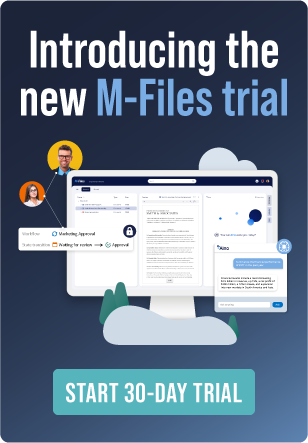What is a Document Management System? And Why is it Useful?

What is a Document Management System (DMS)?
What is a document management system? Put simply, a document management system is an automated business software solution used to organize, secure, store, capture, digitize, and tag business files.
Many document management systems extend beyond basic functionality to include document-related workflows. There are a ton of other add-ons, features and capabilities touted by some document management systems — which has led to other names and designations like enterprise content management (ECM), enterprise information management (EIM) and intelligent information management (IIM).
The term document management often refers to an overarching strategy for how a company stores, manages and tracks its electronic documents.
How does a Document Management System Work?
Business.com claims that there are three main functions of a document management system — to capture, store and distribute documents. Again, in its most basic definition, a document management system should at least do those three things well.
Document Management Systems Should Capture Documents from any Source
A document management system should have a way to input documents and files from varied sources. Some sources might include:
- Scan, capture and digitize from paper files
- Emails and attachments
- External applications like CRM or ERP
- User-generated content saved natively to the document management system
Once documents are loaded into the DMS from whichever source, the DMS should feature a way to index and classify those documents — often with metadata.
Document Management Systems Should Serve as a Central Repository
A basic function of a document management system is to serve as the hub — the central repository — for company files. Many basic DMS require a massive migration project to move all business-critical documents into the system. More advanced intelligent information management solutions like M-Files connect to existing repositories — applying metadata and relationships to documents stored in other systems. With integrations, there’s no need for migration and the environments of other systems can remain undisturbed.
One storage consideration should be information security. A central storage location helps protect enterprise information from malicious actors. With advanced dynamic permissions, organizations can control who has access to certain documents or classes of documents.
Document Management Systems Should Facilitate Document Search and Retrieval
A document management system should make information easy to find for users. With metadata, all files are tagged so that they can be found by a multitude of parameters. For example, metadata for an invoice might be tagged with:
- Parties to the invoice
- Important dates
- Amount
- Business unit or department
- Description of services rendered, or products purchased
With all of that information attached to the document’s metadata, searches yield better results and users can retrieve documents faster and simpler. In M-Files, documents can be found using a Google-like search, which returns the most relevant files first.
What are Document Management Systems Used for?
A document management system is used to automatically organize, secure, digitize and classify company documents, making them easy to access, edit and share. Originally, document management systems were borne as companies sought to shift operations away from a paper-based office — with manila folders and filing cabinets. Since then, document management has taken on a more central role in the enterprise tech stack, facilitating workflows and bridging disparate repositories into a central hub.
What Types of Document Management System are There?
There are a few different types of document management system — depending on how they are classified.
Cloud vs. On-Premises Document Management System
What does your preferred IT environment look like — cloud-based, on-premises or hybrid?
Cloud-based document management systems store your files in the cloud, making them accessible anywhere there’s an internet connection.
Some companies may require on-premises document management, where files are stored on a local server. This may be necessary when certain regulations mandate local storage or when certain countries require data sovereignty, for example.
A hybrid DMS allows for a combination of both options.
Folder-Based vs. Folderless Document Management System
Some document management systems are folder-based — simply using traditional file structures of folders and sub-folders within the system. Other systems are folderless, metadata-based and repository-agnostic like M-Files. In this type of system, it doesn’t matter where a document is stored. The only thing that matters is what the document is — which is a function of metadata.
What are the Main Features of an Effective Document Management System?
As mentioned, a document management system may have several features that graduate into more intelligent information management practices. Some key features to explore in a DMS include:
Search: An effective DMS helps users find documents and information based on document identifiers, metadata, relationships and content.
Metadata: 93% of workers are unable to find a document because it has been poorly named or filed. In a DMS, because information is tagged with metadata based on what it is, the same information can be searched for and found using different criteria depending on the use case. Unique information appears dynamically where it is needed without duplication.
Integrations: Many document management systems integrate with other business systems and repositories — email, network folders, CRM, ERP, legacy ECM and others.
Version control: Version control features ensure access to the latest version of a document. Version control and tracking make it easy to see what has changed, who did it and when the change was made.
Regulatory compliance support: If you operate in a regulated industry, a document management system can help reduce the risk of non-compliance. Users can automate audit trails and manage information and related workflows in accordance with compliance regulations.
Scalability: When selecting a document management system, a company should pay attention to the scalability of that system. Looking beyond current needs, find a DMS that has advanced features that accommodate busines growth or change.
Security: A DMS should provide robust security features like access permission and control features, audit trails, federated authentication, enterprise file encryption in transit and at rest, intrusion detection, data loss prevention, high availability and more.
Usability: Since a DMS becomes core technology for the business, it’s important that the user experience is a great one — with easy accessibility, little to no downtime and simple-to-use features. Employees should be able to easily access, manage and navigate files.
Collaboration: A DMS should make it simple for users to share and collaborate on documents — with features like project document management, task tracking, workflows, co-authoring and easy sharing of documents between users.
Content intelligence: Some advanced document management systems employ artificial intelligence. Artificial intelligence can help classify documents by populating metadata fields, scan files for certain data and separate business-critical data from clutter.
Workflows: Manually managing day-to-day processes isn’t a good use of time. A DMS with workflow automation helps ensure consistency by verifying that every step in a business process is followed. Automated workflows streamline common business processes — like contract approvals, controlled content, and invoicing — sending a notification when there’s a task to be handled.
Remote Work: A cloud-based DMS allows users to access files from anywhere and often from any device — enabling remote work anywhere: at the office, home, airport, hotel, coffee shop… anywhere.
What are the Benefits of Using a Document Management System?
A DMS should make work easier, more productive, and more efficient, saving staff hours of tedious tasks and the exasperation of not finding the documents they need quickly. Main benefits include the following:
Increased Productivity
When workers spend less time searching for documents or tending to manual, repetitive tasks, they have more time to dedicate to value-adding work.
Decreased Security Risk
Keeping information secure and applying dynamic access controls reduces information security risk and exposure. In the event of an unforeseen fire or flood, disaster recovery is simple when documents are stored in the cloud.
Improved Compliance Measures
Compliance requirements for many business documents can be complicated and challenging. A DMS helps organizations avoid fines, revoked licenses or even criminal liability by automating key documents to meet regulatory requirements.
Fast and Easy Document Search
Workers spend an average of 18 minutes searching for a document, according to Forrester. A metadata-based DMS makes it quick and easy to find just the right document.
Enhanced Collaboration
A DMS makes sharing information and collaborating easy, allowing documents from different sources to be accessible from multiple locations. Users can share documents, monitor workflows, co-author documents and more.




